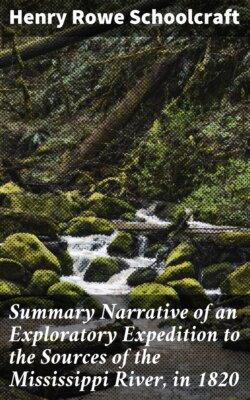Читать книгу Summary Narrative of an Exploratory Expedition to the Sources of the Mississippi River, in 1820 - Henry Rowe Schoolcraft - Страница 19
На сайте Литреса книга снята с продажи.
CHAPTER XIV.
ОглавлениеTable of Contents
Descent of the river from the site of Little Crow's Village to Prairie du Chien—Incidents of the voyage, and notices of the scenery and natural history.
The next morning we embarked at 5 o'clock. On descending the river six miles, we passed the mouth of the St. Croix. [97] This stream heads on high lands, which form a rim of hills around the southern and western shores of Lake Superior, where it is connected with the River Misacoda, or Broulè of Fond du Lac. The Namakagon, its southern branch of it, is connected with the Maskigo, [98] or Mauvais River of La Pointe, Lake Superior. Immediately above its point of entrance into the Mississippi the St. Croix expands into a beautiful lake, which is some twelve miles long, and about two in width. The borders of the Mississippi about this point assume an increased height, and more imposing aspect. In many places, as the voyager descends from this spot to Lake Pepin, he observes the calcareous cliffs to terminate in pyramids; the crest of the hills frequently resemble the crumbling ruins of antique towers. At 12 o'clock we came to the vicinity of an isolated calcareous cliff, called La Grange, which may be regarded as one of those monuments resulting from geological denudation, which constitute a striking feature in the St. Peter's region. The top of this cliff affords a fine view of the scenery of the Mississippi for a long distance above and below it. It has been found to be three hundred and twenty-two feet above the river. [99]
This spot is noted as being near the site of Tarangamani, or the Red Wing's Village. This chief is one of the notable men of his tribe. He has been long celebrated as a man skilled as a native magician. The village consists of four large, elongated, and of several small lodges. Tarangamani is now considered the first chief of his nation. He is noted for his wisdom and sagacity. He bears the marks of being sixty years of age. His grand-daughter married Col. Crawford, a man of commercial activity about Prairie du Chien and Michilimackinac, during the late war of 1812, who has left descendants in the lake country. We observed, at this village, several buffalo skins undergoing the Indian process of dressing. The hair having been removed, they were stretched on the ground, where they were subjected to a process analogous to tanning by being covered with a decoction of oak bark.
In ascending the hill of La Grange, we first encountered the rattlesnake, two of which we killed. This is the highest northern point at which we have observed this species on the Mississippi. I observed on this elevation small detached masses of radiated quartz, cinnamon-colored and white, together with an ore of iron crystallized in cubes. Having cursorily examined the environs, the expedition again embarked. It was 1 o'clock when we entered Lake Pepin. This admired lake is a mere expansion of the Mississippi, having a length of twenty-four miles by a varying width of from two to four miles. During this distance there is not the least current during calm weather. The prospects, in passing through this expanse of water, are of the most picturesque kind. Its immediate shores are circumscribed with a broad beach of gravel, in which may be found rolled pieces of the chalcedonies, agates, and other species of the quartz family, which are characteristic of the drift-stratum of the upper borders of the Mississippi. On the eastern shore, at a short distance from the margin, there is a lofty range of limestone cliffs. On the west, the eye rests on an elevated formation of prairie, nearly destitute of trees. From this plain several conical hills ascend, which have the appearance, but only the appearance, of artificial construction. The lake is quite transparent, and yields several species of fish. The most remarkable of these is the acipenser spatularia, of which we obtained a specimen. It is also remarkable for its numerous varieties, and the large size of its fresh-water shells. I procured several species of unio, which, from their size and character, attracted my attention, particularly to the subject of this branch of American conchology. Several of these, from the duplicates of my cabinet, have attracted the attention of conchologists. [100] Lake Pepin receives a river from the west called the Ocano, or more properly Au Canot; its mouth having been, in former times, a noted place for concealing canoes during the winter season. [101] At a point, on the east shore, about half way down the lake, where a small stream enters, we were informed there existed the remains of an old French fort, or factory; but we did not land to examine them.
In passing through this lake the interpreters pointed to a high precipice in the cliffs on the east shore, which Indian tradition assigns as the locality of a tragical love tale, of which a Dacota girl was the heroine. To avoid the dilemma of being compelled to accept a husband of repulsive character, and to sacrifice her affections for another person, she precipitated herself down this precipice. The tale has been so differently told to travellers visiting the region, that nothing but the simple tradition appears worth recording. Olaita and Winona, have been mentioned as the name of the Dacota Sappho.
